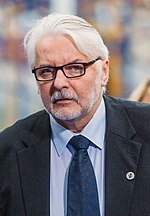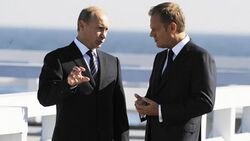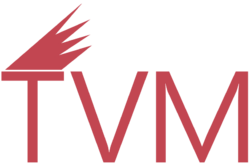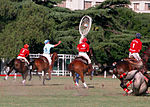West Miersa
This article is incomplete because it is pending further input from participants, or it is a work-in-progress by one author. Please comment on this article's talk page to share your input, comments and questions. Note: To contribute to this article, you may need to seek help from the author(s) of this page. |
Miersan Republic Рэпубліка Мерска Republika Mierska | |
|---|---|
Motto: Буг, Нapуд, Poдзiнa Bóg, Naród, Rodzina "God, Nation, Family" | |
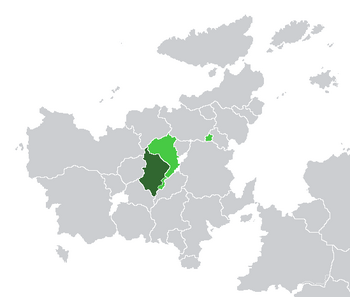 Location of West Miersa (dark green) and claimed but uncontrolled territories (light green) in Euclea. | |
| Capital and largest city | Krada |
| Official languages | Miersan |
| Ethnic groups (2022) | 92.5% Miersan 2.4% Savader 1.7% Soravian 1.1 Lemovican 2.3% other |
| Religion (2022) | 91.7% Catholicism 3.8% Episemialism 4.5% other |
| Demonym(s) | West Miersan Miersan |
| Government | Unitary dominant-party semi-presidential republic |
| Stanisław Kantorowicz | |
• Premier | Aleksander Trzeciak |
| Legislature | Sejm |
| Formation | |
| 1146 | |
| 1623 | |
• Final Partition | 1790 |
| 1936 | |
| 1981 | |
| Area | |
• Total | 232,252 km2 (89,673 sq mi) |
| Population | |
• 2017 census | 17,906,711 |
• Density | 77.10/km2 (199.7/sq mi) |
| GDP (PPP) | 2015 estimate |
• Total | $372.818 billion |
• Per capita | $20,820 |
| GDP (nominal) | 2015 estimate |
• Total | $115.982 billion |
• Per capita | $6,477 |
| Gini (2019) | 31.2 medium |
| HDI (2018) | 0.764 high |
| Currency | West Miersan grosz (MZG) |
| Time zone | UTC-1 (Miersan Standard Time) |
• Summer (DST) | UTC+0 (Miersan Summer Time) |
| Driving side | right |
| Calling code | +97 |
| Internet TLD | .mz |
The Miersan Republic (Miersan: Рэпубліка Мерска; Republika Mierska), also known as West Miersa (Miersan: Mierska Zachodnia), is a sovereign state in central Euclea, comprising the western portion of the historical nation of Miersa. It shares borders with Soravia, Bistravia and Vedmed to the west, Kantemosha to the north, and Champania to the south. To the east, it is bordered by East Miersa, though it claims that the entirity of the Miersan basin, like its eastern counterpart. Krada functions as the capital and largest city. West Miersa has a population of 17.9 million and an area of 232,252 km2 (89,673 sq mi) under its administration, of a claimed 443,367 km2 (171,185 sq mi), including East Miersa and the Lemovician region of Champania.
Miersa was first inhabited by the early Marolevs in the late classical period, as the Solarian Empire expanded into the Miersan hinterlands. Although not conquered by Solaria, the Solarians left a definite legacy in the region. The three first significant Miersan states were known as the Three Crowns, with West Miersa largely constituting Zachódnia and Firencja. They were united with Wybrzeże by Romuald the Bold in 1257. The The kingdom would be a pivotal player in central Euclea expanding into modern day Vedmed, Kirenia, Gaullica and Champania. Much of its land was religiously and ethnically diverse although political power was rooted in the east of the kingdom. In 1623 the king (known as the Cesarz) died without issue, leading to the Miersan Interregnum and the rise of the Miersan Republic. The Republic would be short-lived, with the monarchs of Gaullica and Kirenia both claiming the Miersan throne causing the War of the Miersan Succession. The war ended in 1638 put an end to the Interregnum, with a kingdom being recreated. Land in the east went to Gaullica who began to expand heavily into Miersan affairs causing much of the elite to become Soraviophilic.
The end of the Ten Years’ War would lead to a second partition with most of the territory going to Soravia which emerged as a strong player in the region. A rump state was left behind but in 1790 a final partition during the Euclean Revolutionary Wars was performed. On the pretence of preventing a republic revolution in Miersa the region is finally annexed fully between Soravia and Gaullica. The western provinces became part of Soravia, under which they retained their status as part of the breadbasket of Euclea.
The great war would lead to West Miersa being perhaps the most devastated area in Euclea as the main battleground between Soravia and Gaullica. A unified Miersan republic was planned but the strength of socialist partisans would force the imposition of the Godfredson Plan which divided Miersa between a socialist east and authoritarian west. Aligned with Soravia the west was a corrupt kleptocracy that could not deal with bandits, socialist insurgents and separatists all threatening the rule of law. Hyperinflation, food shortages and corruption kept economic growth low and the country was considered close to a failed state. In 1943 the military with Soravian support took power. They create an efficient police state stabilising the economy and crushing internal opponents.
The collapse of Soravia led to the 1980-1981 Miersan war. The east attempted to annex the west but were unprepared for the conflict and after a few months were bogged down. A ceasefire was signed with the east annexing the Ziarnokosz region and crucially the old capital of Żobrodź. The war led to the junta to collapse with the west becoming an authoritarian dominant-party state.
Today, West Miersa is a unitary dominant-party semi-presidential republic which operates a mixed economy that focuses on natural resources. The current President is Stanisław Kantorowicz who has ruled since 2010. It has a GDP per capita of $11,430. West Miersa is heavily aligned with Soravia, with some commentators considering West Miersa a puppet state. It is a member of the Community of Nations, the International Council for Democracy and Samorspi.
Etymology
Miersa is an Estmerish translation of the endonym Mierska, which is believed to be derived from the name of a tribe. The name of the tribe is believed to translate to peaceful tribe, as the term Mier(a) means peaceful in Ambrazkan, and the name bears similarities to the Proto-Rutto-Marolevic meiˀras, which stands for peace.
The dominant view in academia is because unlike other Marolevic tribes, the Miersans did not leave the Miersan Basin, which was seen by most historians and anthropologists as the original Marolevic homeland. By this view, the Miersans were peaceful because they did not conquer other lands, unlike other Marolevic tribes. However, a prominent dissenting view was that because Miersans saw themselves as less prone to dynastic and civil conflict than other Marolevs, they saw their domains as the "land of peace."
History
Prehistory
Antiquity
Three Crowns
Commonwealth
Disestablishment and foreign rule
Post War
The Great War had wrought large-scale damage to West Miersa. The region was in the midst of famine and had an active socialist insurgency with revolutionary partisan forces frustrating attempts by Soravian authorities to impose political order in the territory. Although Soravian pan-Marolevic ambitions wished to oversee the annexation of the region into Soravia in the summer of 1935 these socialist partisans performed an uprising supported by Kirenia causing them to overrun much of the eastern half of the country threatening Soravia with the possibility of losing control of the entirety of Miersa. To solve the brewing Miersan Crisis the Godfredson Plan was implemented which saw the creation of a Soravian-dominated West and Kirenian-dominated East Miersa as two independent states separated by a demilitarised zone monitored by the Community of Nations.
The new West Miersan government was an unstable republic which became plagued by numerous problems. Hyperinflation, food shortages and corruption keep economic growth low and the country was considered close to a failed state. Governments were very short-lived with political and economic instability very common. In 1943 the army supported by Soravia performed a coup d'état against president Świętosław Wojdyla with marshal Sylwester Krasowsky taking power under the National Military Council (Krajowa Rada Wojskowa; KRW). Under the KRW a repressive military dictatorship was formed which managed to stabilise the economy and end internal unrest. A policy of Soravisation was implemented with the Soravian-West Miersan alliance being deepened. West Miersa would become a puppet state of Soravia with Soravian military, political, economic and cultural influence being dominant throughout society.
Krasowsky would be replaced by another general, Maurycy Jackowiak, in 1961. Under Jackowiak economic development would lead to a gradual increase in the standard of living although corruption and stagnation continued to be pervasive in the national economy. In 1969 there was widespread student protests in the country that were brutally repressed leading to repression to tighten by the regime. Ethnically chauvinist policies towards Soravians, Lemovicians, and Savaders further discredited the government in the eyes of many.

The outbreak of the Sostava War would lead to the west to be thrown into chaos particularly as Soravian forces were recalled to their homeland. In March 1980 East Miersa invaded the west with the intention of unifying the country through force starting the Miersan War. Despite initial victories for the Eastern forces the east was unprepared for the conflict and soon became bogged down due to western resistance. Eastern forces were pushed back at Krada and Dąmyśl causing them to retreat. Due to international pressure both sides eventually agreed to the Treaty of San Alessandro in 1981 ending the Miersan War. Although halting the eastern invasion the west had to cede Ziarnokosz to the east alongside West Żobrodź, the official capital of the country which was moved to Krada.
The war shattered the image of the army as the protector of the nation and facing sustained public pressure Jackowiak was forced to stand down. A civilian was elected president, Tomisław Sobolewski, albeit under the suspicion of vote rigging from the army. Without West Miersa's major benefactor Soravia - still embroiled in civil war - Sobolewski began to pursue a policy of isolationism, closing the country's borders and implementing a policy of economic autarky. Launching a campaign of Miersiation known as sanacja Sobolewski intended to create a "Miersa for the Miersans" with cultural homogeneity was heavily advocated whilst languages such as Soravian, legalised in 1940, were once again banned. The sanacja programme would result in the ethnic cleansing of Soravians, Lemovicians, and Savaders often by paramilitary units that were little more then armed gangs. In July 198X demonstrations calling for greater civil rights for Lemovicians leading to the government to bloodily suppress the rebels by shelling the city of Mistozburo. The Mistozburo massacre would only further fuel resistance to the government and in August 198X the Lemovician People's Army (LPA) began a guerrilla war against West Miersa. Increasingly genocidal tactics from the government led to Champania to intervene easily defeating the west Miersan government and annexing Lemovicia into Champania.
During the latter half of the 1980s and early half of the 1990s west Miersa became marked by corruption, organised crime and ethnic violence leading to very high emigration. Political isolation ended in 199X when West Miersa joined Samorspi. Economic liberalisation helped lead to the western economy to recover although corruption remained rampant as did political repression with Sobolewski continuing his hold on power.
Sobolewski resigned in 2007 due to illness being replaced by his protégé Stanisław Kantorowicz. Purging internal opponents Kantorowicz's presidency saw a gradual shift away from the policies of his predecessor opening up West Miersa to foreign investors, privatising state-owned enterprises, scaling back the programme of Miersiation and pursuing a foreign policy of "reconciliation and trust building" with West Miersa's neighbours. Kantorowicz has notably put relations with Soravia at the forefront of his presidency and under his rule west Miersa is noted to have undergone "Soraviasation" once again.
Geography

Most of West Miersa is situated in the Miersan Basin, resulting in the country being largely flat. However, the western and southern regions are flanked by hills and mountains, such as the Pogórze Hills, which are situated along the western border with Vedmed and Soravia, and the Mendija Mountains in Małomiersa.
The Miersan Basin is part of the greater Euclean Steppe. Due to its flat geography and its climate, the area has traditionally supported agriculture, which has historically allowed sizable populations to exist. However, the geography has made it vulnerable to foreign incursions, such as efforts by the Solarian Empire to take control of the area, by Vedmedis during the migration to present-day Vedmed, and by Soravians and Gaullicans, who partitioned the country between themselves. The average elevation is around 200 metres above sea level, although sea level decreases the further east one goes, with the lowest point being at the easternmost point under West Miersan control, Chochołów, at only 77 metres above sea level.
The Mendija Mountains is largely situated along the border with Bistravia, Champania, and the breakaway state of Lemovicia. Officially, the country's highest point, at 2,655 metres high, is at Mount Sztiawnica, along the border with Champania, but as it is situated in the breakway state of Lemovicia, the highest point under West Miersan control is at the 2,072 metre high Mount Szczesny, also along the border with Champania.
Climate
Due to its geography and position in central Euclea, West Miersa has a warm-summer humid continental climate, with the warmest months averaging a maximum of 25.1 °C and the coldest months averaging a minimum of -10 °C. The hottest temperature was set on 8 August, 2019 in Sechia where it reached 40.3 °C.
However in the Mendija Mountains, although it is closer to the equator and tropics than the rest of the country as the elevation is higher, on average the Mendija Mountains a hot dry-summer continental climate with average temperatures ranging form a low of −8.0 °C in January to a high of 30.8 °C in July. The highest elevations give an alpine climate. The lowest recorded temperature was set on 2 February, 1962 on the summit of Mount Sztiawnica at -43.9 °C on the summit.
Environment
Government and politics
The Miersan Republic is officially a unitary semi-presidential republic. The head of state is the president while the head of government is the premier. The legislature of West Miersa is the National Assembly whilst the highest judicial body is the Supreme Court. West Miersan Constitution has been in place since 1981 having being amended several times since. There is heavy centralisation with the voivodeships effectively being subservient to the central government in Krada.
The president is the main executive figure in West Miersan politics being the commander-in-chief of the armed forces, appointed the premier and having the power to veto legislation. The president is directly elected every five years alongside the National Assembly both using a first-past-the-post voting system. The premier is nominated by the president subject to a vote of confidence by the National Assembly. The current president Stanisław Kantorowicz has served in the role since 2007 while the current premier Aleksander Trzeciak has served since 2020.
The National Assembly comprising of 307 seats, of which 138 seats are represented by elected legislators from the nine voivodeships under West Miersan control, while the remaining 169 seats are appointed by the President to represent the voivodeships under East Miersan control. The executive is the cabinet known as the Council of Ministers which consists of 16 ministers.
West Miersa is commonly considered to be a dictatorship under the president. The neo-functionalist Popular National Union (Звiѫзeк Љyдoвo-Нapoдoви, Związek Ludowo-Narodowy; ЗЉН/ZLN) is the dominant party having won every election since its creation in 1990. According to a report by the CN Human Rights Committee the West Miersan government "consistently engages in systematic human rights violations". West Miersa has remained under a state of emergency since the Lemovican War in 1982 having used the law to supress political dissent.
Administrative divisions
West Miersa is officially divided into seventeen voivodeships (Miersan: вojeвyѕтвo; województwo), of which nine are entirely or partially under the control of the West Miersan government. Under the West Miersan constitution, the voivodeships officially have extensive powers but in practice their authority has been curtailed by the central government.
| Map | Voivodeship | Capital | Population |
|---|---|---|---|
| Chernowskie | Łószcław | 0 | |
| Czękanie | Zanica | 1,958,772 | |
| Dolne Pogórze | Podgórzyca | 3,125,697 | |
| Górne Pogórze | Zieruń | 1,747,797 | |
| Małomiersa | Sechia | 1,487,711 | |
| Śródmierskie | Dąmyśl | 778,666 | |
| Święciżar | Krada | 4,195,787 | |
| Wyżyny | Gorgard | 719,596 | |
| Zanawiwasie | Gdawiec | 815,779 |
Foreign relations
The foreign relations of the Miersan Republic have been influenced by Soravia's own foreign policy, with West Miersa following in tandem with Soravia's foreign policy. As a close ally of Soravia, West Miersa is a full member of Samorspi since 1991, and participates in the Tsivebi Military Agreement. This level of integration within Samorspi has meant that West Miersa very rarely exercises an independent policy from the rest of Samorspi.
Relations with Soravia are complex. A history of repression by Soravia has led to the west to at times distance themselves from their larger neighbour - during the Sostava War the western government undertook a campaign of Miersiation of the Soravian minority with some commentating that Soravians in the country faced an ethnic cleansing under the government's sanacja policy. However since the 1990s West Miersa has reaffirmed relations with Soravia joining Samorspi and economically integrating with Soravia to the extent of being considered to be a client state.
However, relations are hostile towards the socialist states, particularly East Miersa, which according to the West Miersan constitution is defined as the "eastern voivodeships under Kirenian occupation." These poor relations have been exacerbated by both the Miersa War from 1980 to 1981, and by the Lemovician War.
Due to its small population and lack of influence on the international stage outside of Samorspi, West Miersa's diplomatic missions are largely confined to Euclea, with only a handful of embassies outside of Euclea, mainly in countries with a sizable Miersan diaspora, or major powers.
Military
The Miersan National Armed Forces are the military forces of West Miersa, comprising of 190,178 total personnel as of 2020. It is divided into the Miersan National Army, the Miersan National Air Force and the Miersan Riverine Guard. Despite its large size, and its higher budget (at 3.1% of the country's gross domestic product), it is technologically inferior than the East Miersan People's Protection Forces.
Conscription is still practiced in the Miersan National Armed Forces, with all men aged 18-30 required to serve an eighteen month term in the Miersan National Armed Forces, excluding those who have a disability "which hinders their ability to serve." Conscientious objection is not recognised. However many avoid national service through paying bribes leading to conscription to be haphazardly enforced overall.
In addition to the Miersan National Armed Forces, the Miersan Republic is a participant in the Tsivebi Military Agreement, allowing Soravia to establish military bases on West Miersan territory, and there are several paramilitary forces affiliated with the West Miersan government to assist with defence if needed.
Law
Economy

As of 2015, the nominal gross domestic product of the Miersan Republic was at $115.982 billion, with a nominal gross domestic product per capita at $6,477. If purchasing power parity is used, the West Miersan economy is valued at $372.818 billion, with a purchasing power parity per capita of $20,820, making it poorer than East Miersa.
West Miersa is a mixed economy, as while many private companies exist, such as budget airline Tad, TBD, and the Miersan National Bank, the government has substantial involvement in the economy, such as GAZM, which has a legal monopoly on the production and distribution of natural gas, KrayElektry, which has a legal monopoly on the production of electricity in the Miersan Sotirian Republic, and TeleMiers, which until the 1990s had a monopoly on telephony and telegraphy, and to this day also serves as an internet service provider.
In 2015, 53% of the working population were employed in the tertiary sector, mostly in service industry jobs, while 39% of the working population were employed by the secondary sector, mostly in mining, with very few still working in the manufacturing sector, and the remainder of the working population employed in agriculture. 75% of the total population are employed, while around seventeen percent are in education, and the remaining eight percent are unemployed.
The currency of the Miersan Republic is the grosz (gr), officially divided into 100 kopyky, although in practice, the kopyky has never been used in decades.
Transportation
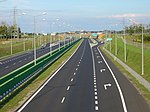
West Miersa, due to its geographical position in the centre of Euclea, is well-connected to most of its neighbours by rail, road, and air. It has a fairly large railway network, operated by Miersan National Railways, which not only maintains the railway network, but also provides passenger and cargo service. Although plans are in existence for the potential development of a high-speed rail line connecting Krada with West Żobrodź, there is no definitive start date planned for the construction of the line.
West Miersa's road infrastructure is not well-developed by Euclean standards: although there are 412,264 kilometres of roads as of 2017, including 4,203 kilometres of motorways, which connect the major cities of West Miersa to each other, and to Kantemosha, Champania, Bistravia, Vedmed, and Soravia, 131,863 kilometres were unpaved in that year. While the motorways (numbered A-XX) are of good quality, most roads, particularly in rural areas, are of poor quality.
There are three major international airports, those being the Krada International Airport in Krada, Świętosław Wojdyla International Airport in West Żobrodź, and Sechia International Airport in Sechia, while there are two major airlines based in West Miersa: flag carrier Miersair and budget airline Tad.
Demographics
As of the 2017 census, the Miersan Republic officially has 17,906,711 people in its territory, excluding those in the eastern voivodeships, as well as those under separatist control in southern Malomiersa.
Education
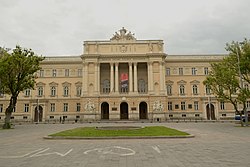
Education in West Miersa has generally followed the Soravian education model, and thus, like Soravia, education is compulsory between the ages of 5 and 16.
From the age of six weeks to 3 years of age, children can attend a żłobek programme, while from the ages of 3 and 4, they can attend a przedszkole. While these are optional and are equivalent to daycares in other Euclean countries, they are taught basic skills, such as letters, basic vocabulary, basic mathematics, and how to cooperate with others. At the age of 5, mandatory education begins, with all students required to go to a dzieciniec, though the dzieciniec is similar to the przedszkole.
When students turn 6, they begin primary education: like Soravia, while Year One starts out similar to a dzieciniec, more formalized structures get put into place, with students building on the skills they learnt in the previous year, until by the end of the year, the formalized structures are put into place. This structured learning environment is maintained with little alterations until students turn 11, when they take the State Assessments: if one gets high scores, they go to more prestigious schools: otherwise, they go to less prestigious schools.
Thus, students enter high school when there 11-12 years of age, and although students now go from class-to-class, and they can start to choose courses, they still have to learn mandatory subjects until they're 15-16, when they have the option of either going to the workforce or enrolling in college, where they can spend the next two years studying for classes so they can pass the college exams.
If one passes the college exams, they can attend a university, with five accredited universities existing as of 2019: the University of Żobrodź, the University of Krada, the University of Sechia, the University of Lojola, and Podgórzyca University. If they do not pass, they attend a vocational institute, or otherwise go straight into the workforce.
Ethnicity
Of the 17,906,711 people residing in the Miersan Republic, the largest ethnic group are the Miersans, comprising 68.7% of the population, or 12,298,192 people, and spread out across West Miersa. The next largest ethnicity are the Soravians, comprising 18.7% of the population, or 3,349,476 people, and predominantly concentrated near the border with Soravia, Vedmed, and Kantemosha, and also in major cities like Krada, Sechia, and West Żobrodź.
Of the remaining 12.6% of the population, major minority groups among the remainder of the population include the Radushians, who form 3.1% of the population, or 555,108 people, followed by the Vedmedis, forming approximately 1.8% of the population, or 314,770 people, Lemovicians, forming 1.1% of the population, or 199,061 people, Savaders, forming 0.8% of the population, or 149,345 people, and Kantemoshans, who form 0.7% of the population, or 125,347 people. A wide array of ethnic groups form the remainder of the population.
Religion
Language
Largest cities
Largest cities or towns in West Miersa
2017 census | |||||||||
|---|---|---|---|---|---|---|---|---|---|
| Rank | Voivodeship | Pop. | Rank | Voivodeship | Pop. | ||||
 Krada  Sechia |
1 | Krada | Swiecizar | 891,411 | 11 | Dlugopol | Starykrol | 63,672 |  Podgorzyca  Gorgard |
| 2 | Sechia | Malomiersa | 297,137 | 12 | Most Bytnara | Swiecizar | 59,427 | ||
| 3 | Podgorzyca | Starykrol | 222,843 | 13 | Bonczek | West Zobrodz | 55,713 | ||
| 4 | Gorgard | Wyzyny | 178,281 | 14 | Bystok | Starykrol | 52,436 | ||
| 5 | Zanica | Czekanie | 127,344 | 15 | Domwiej | Malomiersa | 46,916 | ||
| 6 | Rycerow | Zanawiwasie | 111,426 | 16 | Zamek Strazniczy | Krowielie | 44,571 | ||
| 7 | Tarclaw | Swieciżar | 99,046 | 17 | Debowo Lesne | Swiecizar | 42,448 | ||
| 8 | Damsyl | Krowielie | 89,146 | 18 | Mostar | Malomiersa | 40,519 | ||
| 9 | Zierun | Jelenawie | 81,037 | ||||||
| 10 | Wisniow | West Zobrodz | 68,571 | ||||||
Culture
Art
Cuisine

Cuisine in West Miersa has been traditionally informed by Miersan cuisine. To this end, Miersan cuisine has many elements in common with neighbouring cuisines, due to the history of Miersa, both as an independent state, and under foreign rule. However, Miersan cuisine is traditionally very hearty, and rich in meat, as well as a whole host of vegetables.
Traditionally, Miersans eat two meals a day: breakfast (śniadanie), and dinner (kolacja), with each meal being divided into three courses.
The first course is the soup course, with popular varieties of soup consumed in West Miersa including sour cucumber soup, mushroom soup, rosół, and flaki. Following the soup course, there is the main course, with popular Miersan dishes including bigos, pierogi, gołąbki, and kielbasa. Finally, dessert is served, which usually comprises of a makowiec, a kremówka, or cheesecake.
A third meal, lunch (obiad), is often consumed, particularly among those living in cities, and among younger generations. However, it often only comprises of one course, usually purchased from restaurants specialising in street food. Popular street foods in West Miersa include chaczapuri, kebabs, sausages, and zapiekanka.
Media
West Miersan media has, and continues to be, heavily affected by censorship and restrictions that infringe on the ability of journalists to report the news. Media censorship has increased, particularly among left-wing outlets and those critical of the West Miersan government.
The main television and radio network is Telewizja Mierska, a state-run broadcaster which operates television stations, and the state run Radio Mierska, which operates radio stations. However, since the 1980s, there has been a growth in privately-owned radio and television stations, with most of the new radio and television stations basing themselves in Krada, with the largest privately-owned radio network being TERAZ! Radio, and the largest privately-owned television network being Telewizja Środkrai. The most popular newspapers are the Obserwator and Codzienny, which are based in Krada, and are broadsheet newspapers, which focus on national news. Most cities in West Miersa have a newspaper of some kind tailored to local news.
While until the mid-2010s, the internet had not been tightly regulated, since the mid-2010s, internet censorship has increased, particularly against sites critical of the West Miersan government and against left-wing outlets.
Sports
Due to the geography of Miersa, equestrianism has historically been popular among the Miersan people, although since the nineteenth century, the most popular equestrian sport in present-day West Miersa is zadany, although other equestrian sports, such as dressage are still popular in Miersa.
Due to Soravian influence over West Miersa as a result of its rule, basketball and football have become popular sports, with West Miersa having the MZK as the highest basketball league in the country, and the Miersan Football League as the country's main football league. The national basketball and football teams have competed in many competitions. In recent decades, ice hockey has grown in popularity, although it pales in comparison to Soravian's ice hockey team.
As a result of its division, West Miersa's primary rival is East Miersa, although in recent decades, they have entered competitions as a joint Miersan team.
Public holidays
| Date | Estmerish name | Miersan name | Description |
|---|---|---|---|
| 1 January | New Year's Day | Nowy Rok | Celebrates the start of the year |
| 6 January | Nativity Eve | Wigilia | Celebrates the birth of Jesus Sotiras |
| 7 January | Nativity Day | Boże Narodzenie | Celebrates the birth of Jesus Sotiras |
| 19 January | Epiphany | Olśnienie | Commemorates the baptism of Jesus Sotiras |
| A Sunday in Spring | Paschal Sunday | Wielkanoc | Celebrates the resurrection of Jesus Sotiras |
| 40 days after Paschal Sunday | Holy Thursday | Święty czwartek | Celebrates the ascension of Jesus Sotiras to heaven |
| 50 days after Paschal Sunday | Pentecost | Zielone Świątki | Commemorates the descent of the Holy Spirit |
| TBD | Memorial Day | Dzień zabójstwa | Commemorates the end of the Miersan War and all those killed on the line of duty |
| 15 August | The Dormition | Zaśnięcie | Commemorates Mary entering Heaven alive at the end of her life |
| 3 October | Independence Day | Dzień Niepodległości | Celebrates the independence of the Miersan Republic from Soravia |
| 31 December | New Year's Eve | Sylwester | Celebrates the end of the year |




